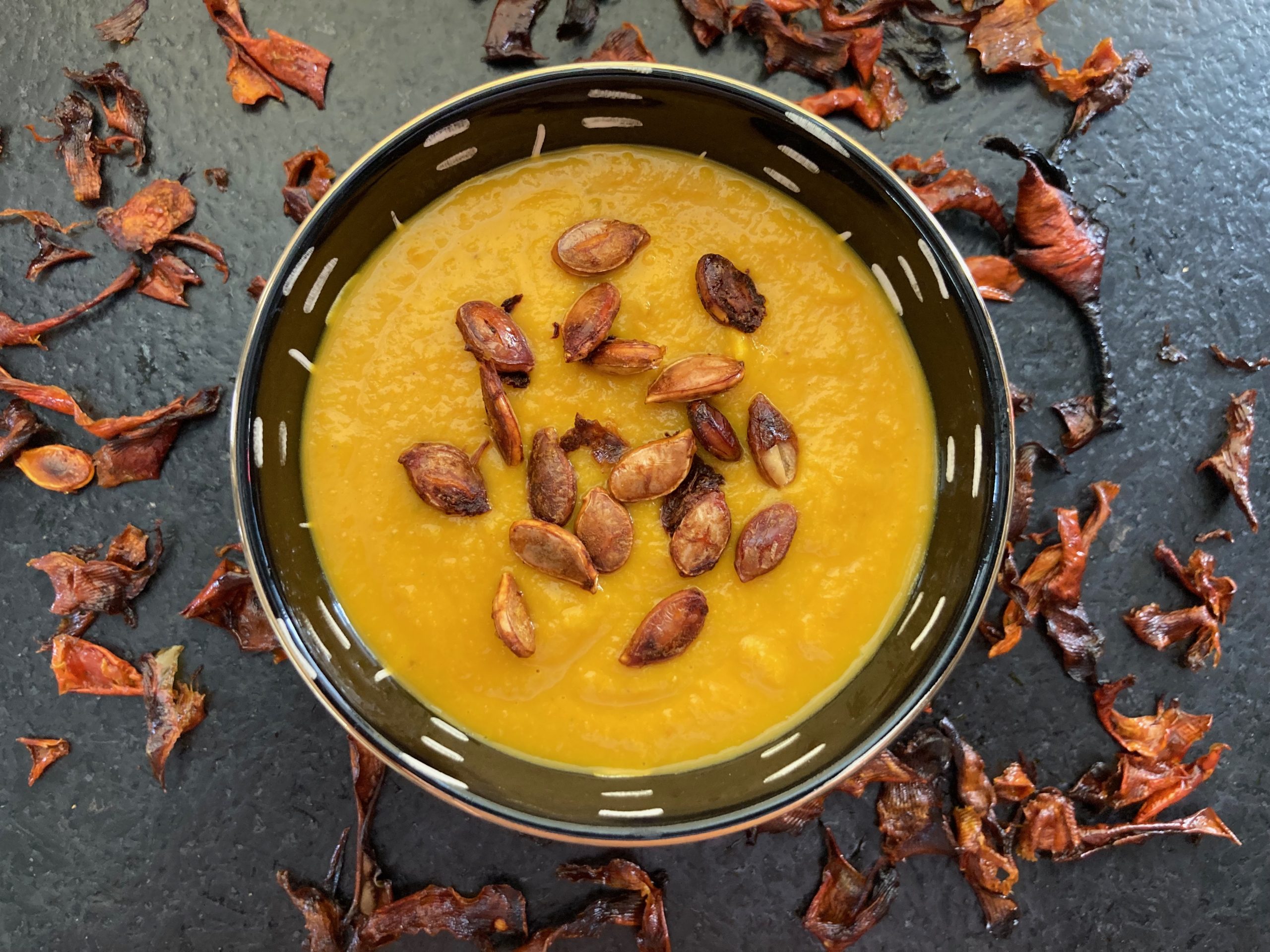
For the word file, click here: The Color Orange
The Color Orange
From Puree to Soufflé
Orange foods taste good together. Maybe it’s my imagination, or just a coincidence. Or maybe it’s the beta-carotene pigment that’s found in all orange foods. But probably not, because beta-carotene has no flavor. It is, however, a precursor to Vitamin A, which is good for vision, which will help you see that orange foods look good together. It’s the color of autumn, what’s left in the foliage after the green recedes.
Ginger, meanwhile, is an honorary orange food. It may not look overly orange, but ginger is a term often used to describe red-headed people. Ginger has a feisty and expansive flavor, like the purported personalities of redheads. And ginger does, for the record, contain beta-carotene. And if that’s not proof enough to affirm ginger’s red reputation, I have a recipe that will.
This all-orange dish includes carrots, squash, egg yolks, red chile, and even orange the fruit. You can’t get much more orange than that. And it’s even better with ginger. The recipe is for a savory soufflé that puffs up like a cracked balloon in the oven. This is not your typical dessert soufflé, but one for the main course. I serve it drizzled with a tangy orange sauce.
This beta-carotene soufflé is actually several recipes in one. The first step is to make a beta-carotene puree, which doubles as a great soup. And the orange sauce I serve it with is useful in many ways. In addition to drizzling the orange sauce on the soufflé, you can use it to orange up the soup, as well as on roasted vegetables, fried chicken, and anything else that could benefit from a sharp and overtly orange zing.
Beta-carotene Puree
This puree is the first step in making Ginger Souffle, and also makes a lovely autumn soup. Most any winter squash will work here. My favorites are butternut, kabocha, sunshine, red kuri.
Makes 3 quarts. Whatever you don’t use for soup or souffle can be frozen.
1 winter squash (2-3 lbs)
4 medium carrots, peeled (about 12 oz)
1 medium onion, minced
2 tablespoons butter
4 tablespoons extra-virgin olive oil
4 cloves of garlic
5 leaves fresh sage
2 quarts chicken stock
1 piece of ginger, about an inch on a side, grated
1 tablespoon paprika or chile flakes
Preheat the oven to 400. Cut the squash in half from tip to stem. Scoop out the seeds and membranes. Peel the squash with a knife or a peeler. Then lay the cut sides down and cut ½-inch slices from pole to pole. Make the slices as even as possible, like you’re slicing bread, so they cook evenly. Cut the carrots into rounds as thick as the squash slices.
(With thin, edible skinned squash like kabocha or sunshine, I toss the peels with salt and olive oil bake them too. The skins cook quickly into into a crispy treat that’s addictive as potato chips, but with more carotene. I also bake the seeds.)
Toss the squash and carrot slices in 2 tablespoons olive oil and cook then until they are thoroughly tender, about 30 minutes. The baked peels will only take about 7 minutes, and the seeds about 15.
While the squash and carrots are baking, saute the onions, garlic and sage in the butter and remainder of the olive oil, on medium heat. When the onions are translucent, add the chicken stock, the squash and the carrots. Bring to a simmer and then turn it off, and let it cool.
When it’s cooled to the point where you can work with it, add the ginger and paprika, and puree it all together.
To serve it as a soup, add a splash of heavy cream and garnish with roasted seeds and or peels.
Ginger Soufflé
This dish is an adaptation of a butternut squash soufflé recipe created by John McDonald, who writes about wine in the Cape Gazette of Lewes, Delaware.
Makes four pint-sized souffles (or two pints when puffed)
2 tablespoons butter
2 tablespoons white flour
½ cup milk
¼ cup heavy cream
1 cup of Beta-carotene puree
3 eggs
¼ teaspoon salt
Preheat the oven to 450. Melt the butter in a heavy-bottomed omelet pan or saucepan on medium heat. Add the flour, and whisk it together until completely combined. Add the milk and cream and whisk it together. Finally, add the puree and salt, and whisk it again.
Separate the eggs. When the contents of the pan have cooled for ten minutes, add a tablespoon of the mixture to the egg yolks and whisk it in. This tempers the yolks so they don’t cook when you mix it all together. Add another tablespoon and whisk it in. And another. Then add the rest of the orange mixture to the yolks, and thoroughly mix.
Beat the egg whites in a medium-sized bowl until peaks form. Gently fold the stiff whites into the batter.
Divide the batter among four buttered pint-sized ramekins, and bake until golden and well-risen – about 15 minutes. Drizzle with orange sauce, if using, and serve immediately. They will probably collapse, like soufflés will do. But that won’t impact the flavor.
Orange Sauce
This orange sauce is based on what’s on the orange chicken found on the menu of your favorite Chinese restaurant.
Note: in the above photo I made a browner version of the sauce, for more contrast with the orange souffle. I replaced the white sugar with brown sugar, and the salt with 2 tablespoons of soy sauce.
½ ounce garlic, minced or grated finely
½ ounce ginger, peeled and minced or grated finely
Juice and zest of two juicy oranges
1 tablespoon rice vinegar
4 tablespoons white sugar
1 teaspoon of salt
Combine all of the ingredients in a blender and puree. Pour it through a strainer into a saucepan. On medium heat, cook it down to about half the original volume.
